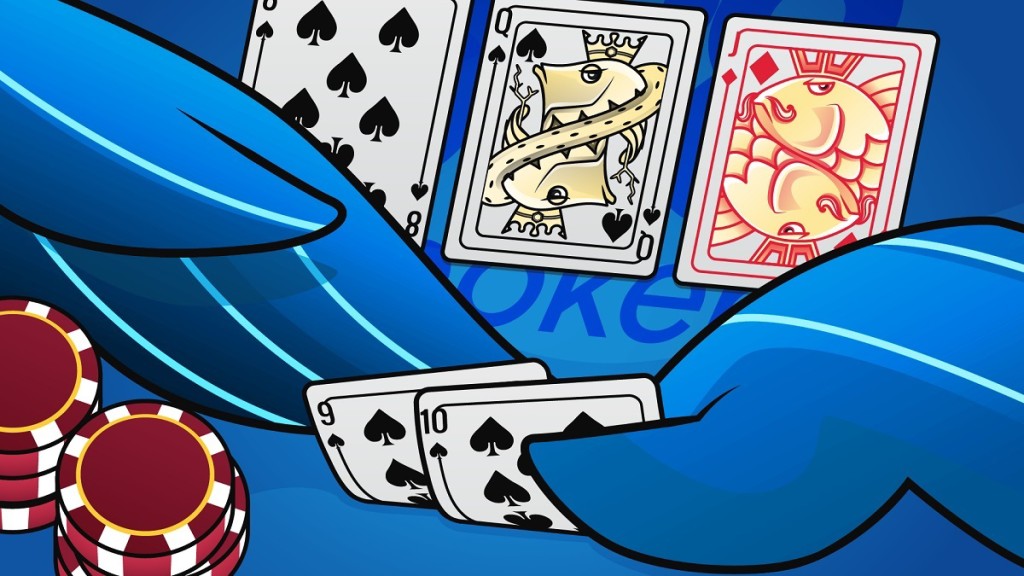What is a straight?
A straight is a run of five consecutive unsuited cards, where Aces can be high or low (A-5 or 10-A). If the five consecutive cards are suited then you’ve got the rare and beautiful straight flush.
If you think of a straight as the silent assassin at the poker table, you won’t go too far wrong. It can appear out of nowhere and strike without fear, but when left out in the open can suddenly become vulnerable and significantly less fearsome. It can be viewed as the poor relation of the flush in ‘big hand’ stakes, but a well-played straight can still be a devastatingly effective way for you to win a lot of chips.
You will occasionally flop a straight but more often than not you’ll make a straight after drawing to two or three of the flop cards. You might have just one card in your hand that is active in the draw, such as 7-7 or A-7 on a 4-5-6 board, or more often two connected cards on a favourable flop, like J-10 on a board of 2-9-Q.
Your first concern should be whether your draw is open-ended, meaning you can hit either end of the straight (eight outs), or a gutshot (four outs), where there is just one way to make your hand, e.g. you need an Eight when you hold 9-10 on a 6-7-J board. The odds of hitting a gutshot are naturally going to be more restrictive (8.51% on the turn and 16.47% by the river) than an open-ended straight, which gives you a lot more scope to make your hand (17.02% on the turn and 31.45% by the river).
Straighten them out
Your next consideration is whether you think you will have the best hand if you actually hit one of your straight outs. Is there a flush draw on board? If there is and you think your opponent might be chasing it then you should probably discount the straight outs that would also bring a flush. For instance, if you have 
 on a
on a 

 board you have to be cautious about the
board you have to be cautious about the  and
and  . They both complete your straight but can also complete someone else’s flush draw. In these cases it’s often best to think of each out as a ‘half out’ and work out your pot odds on that basis. And if the action really hots up you shouldn’t hesitate to muck your straight if you believe someone to have made their flush. Don’t make stubborn calls!
. They both complete your straight but can also complete someone else’s flush draw. In these cases it’s often best to think of each out as a ‘half out’ and work out your pot odds on that basis. And if the action really hots up you shouldn’t hesitate to muck your straight if you believe someone to have made their flush. Don’t make stubborn calls!
Playing your draw
Your next consideration is whether to play your made or drawing hand fast or slow. Because while nut flush draws often represent a +EV shove, moving in with straight draws can be a different matter…
The reason, of course, is that a flush draw will hit more often than a straight and a shove will usually be with overcards to the board giving as many as 15 outs sometimes. In contrast when you have straight draws you also tend to have weaker hole cards. For this reason you need to be a bit more conservative, but when you sense weakness a push can still be a good semi-bluff.
When play is deep-stacked, ideally you’ll be last to act as you’ll get to see what price is being set for your draw. In most cases, especially if you only called pre-flop, you should check if you’re lucky enough to be offered a free card. In the more likely case of facing a bet you need to understand pot and implied odds.
Put simply, don’t put more money into the pot than the chance you have of winning the hand. If you think the only way you’ll win is to hit your open-ended straight and a guy makes a pot-sized shove for 3,000 you can’t call profitably because you’ll be putting in 33% (3,000 into a 6,000 pot) but will hit only 31.5% of the time. If the stacks are deeper and you think you can felt your opponent when you make your hand, then paying over the odds to see the next card can sometimes be justified, as you’re speculating in the knowledge that they will pay you off when you make your hand. Just don’t justify every donkey call this way!
If you were the pre-flop aggressor you need to choose between making a continuation bet and running the risk of being check-raised, or checking, then missing your draw and letting go of the momentum you created with your earlier raise. A raise from position with a strong open-ended draw can often be preferable, as it might win you the pot right away. And if you’re called and hit your draw you’ve built the pot and have disguised your hand well.
Flopping a monster
You call a raise in late position with 7-8 and pick up both an open-ended straight draw and a pair on a 6-7-9 rainbow flop. Against someone holding A-K you’re now an 80% favourite, and even against pocket Aces you’re close to 45% to win. These monster flops can be played slow or fast according to the situation, but by getting your chips in the middle and putting other players to the test with your aggression you can’t go too far wrong.
Don’t be an idiot
Just because there’s no flush or full house on board, you shouldn’t assume that your straight is the winning hand… If you hold 
 on a
on a 



 board you hold the lowest possible straight – otherwise known as the idiot end of the straight. Do you think your opponent could have K-Q or Q-8? If so, be prepared to wind your neck in or you could find it on the chopping block all too easily. Naturally, you shouldn’t be afraid to value-bet if your opponent hasn’t shown strength, but don’t snap-call a big river bet or raise without thinking back through the hand. It could be a costly error.
board you hold the lowest possible straight – otherwise known as the idiot end of the straight. Do you think your opponent could have K-Q or Q-8? If so, be prepared to wind your neck in or you could find it on the chopping block all too easily. Naturally, you shouldn’t be afraid to value-bet if your opponent hasn’t shown strength, but don’t snap-call a big river bet or raise without thinking back through the hand. It could be a costly error.
The stats
How often will you flop a straight with 9-10? 1.31%
What are the chances of making a backdoor straight? 4.2%
What are the chances of hitting an open-ended straight draw from the flop to river? 31.5%
How often will you be dealt connecting cards? 15.7%
What are the chances of hitting a gutshot on the turn? 8.5%
Tagged with: beginner strategy • Cash Games • how to play • poker strategy



2 Responses to “How to Play a Straight”
Comments are closed.